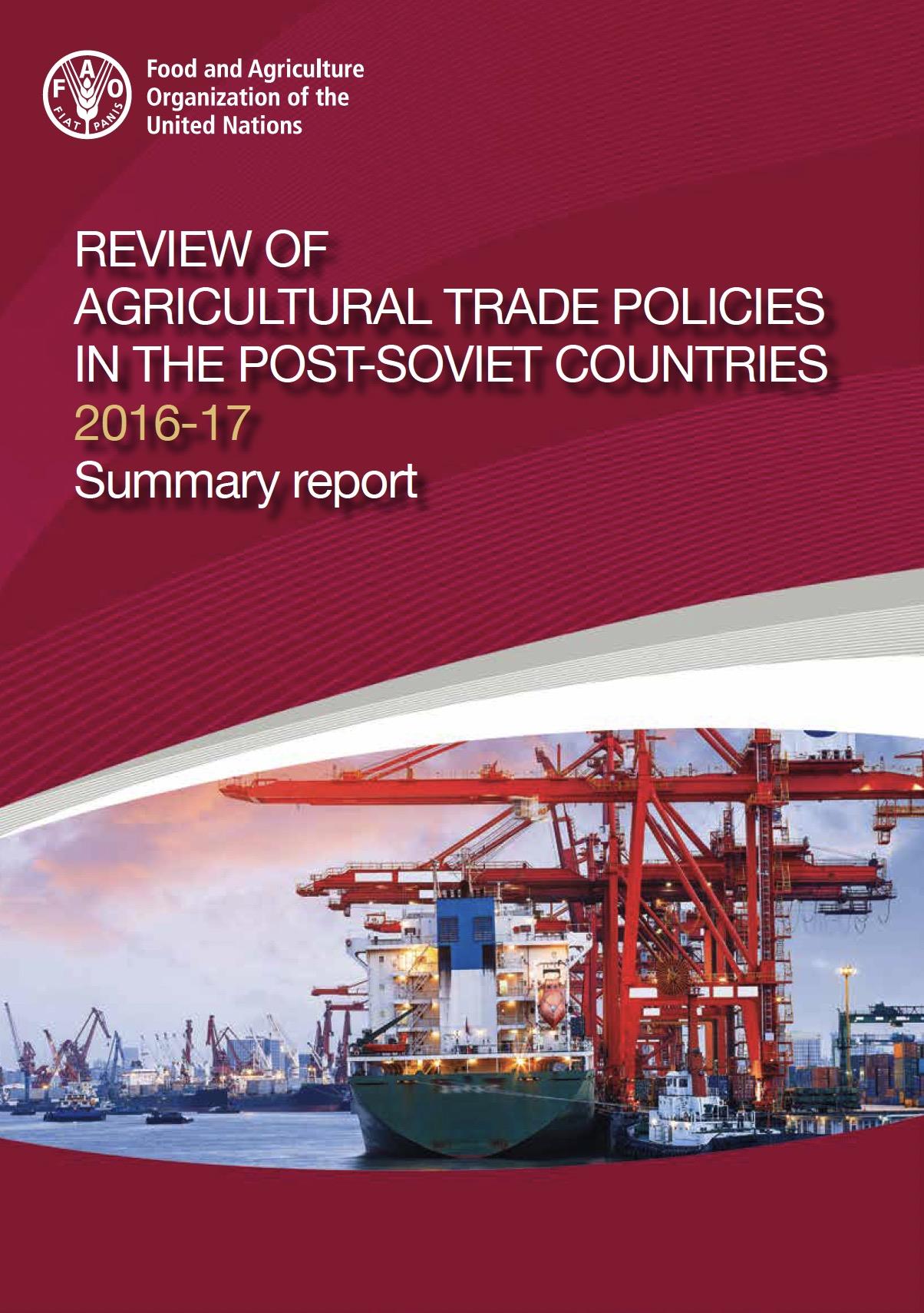
Review of agricultural trade policies In the post-soviet countries 2016-17
22/10/2018
This document presents an English summary of the “Review of Agricultural Trade Policies in the post-Soviet countries 2016-2017” (FAO, 2018) available in Russian. The purpose of the publication is to provide an overview and analysis of the trends in agricultural trade and trade policies in the post-Soviet countries. The annual review serves to enhance transparency in agricultural trade policy measures, contributing to more stable and effective trade in the Europe and Central Asia region. This summary begins with an overview chapter presenting key developments in agricultural trade in twelve post-Soviet countries in 2016-2017, followed by regional strategies and programmes for agricultural export development, and includes short country chapters on Armenia, Azerbaijan, Belarus, Georgia, Kazakhstan, Kyrgyzstan, the Republic of Moldova, the Russian Federation, Tajikistan, Turkmenistan, Ukraine and Uzbekistan.
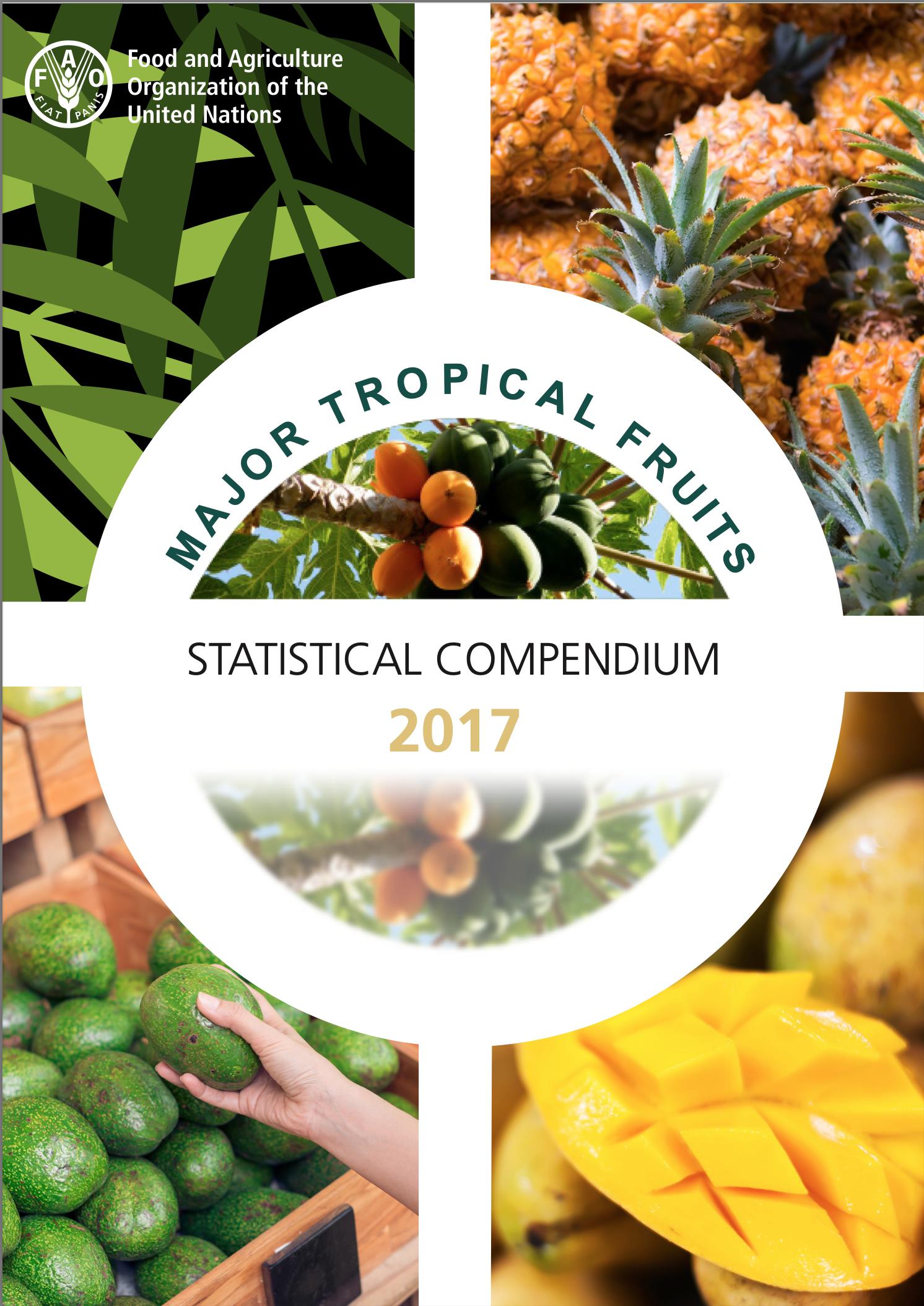
Major Tropical Fruits - Statistical Compendium 2017
12/10/2018
The Statistical Compendium includes all data used to prepare the Tropical Fruits Market Review 2017 analysis, in particular, production export and import volumes and flows, and price indications.
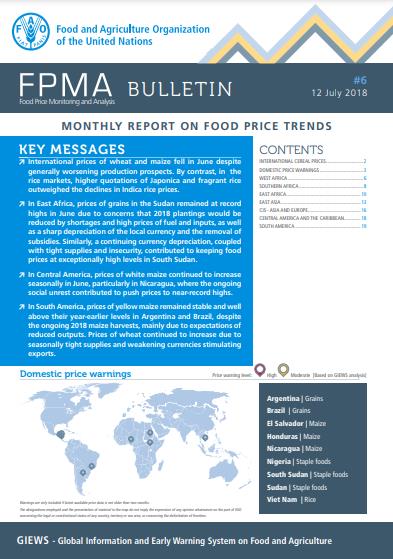
Food Price Monitoring and Analysis (FPMA) Bulletin #6, 12 July 2018
12/10/2018
International prices of wheat and maize fell in June despite generally worsening production prospects. By contrast, in the rice markets, higher quotations of Japonica and fragrant rice outweighed the declines in Indica rice prices. In East Africa, prices of grains in the Sudan remained at record highs in June due to concerns that 2018 plantings would be reduced by shortages and high prices of fuel and inputs, as well as a sharp depreciation of the local currency and the removal of subsidies. Similarly, a continuing currency depreciation, coupled with tight supplies and insecurity, contributed to keeping food prices at exceptionally high levels in South Sudan. In Central America, prices of white maize continued to increase seasonally in June, particularly in Nicaragua, where the ongoing social unrest contributed to push prices to near-record highs. In South America, prices of yellow maize remained stable and well above their year-earlier levels in Argentina and Brazil, despite the ongoing 2018 maize harvests, mainly due to expectations of reduced outputs. Prices of wheat continued to increase due to seasonally tight supplies and weakening currencies stimulating exports.
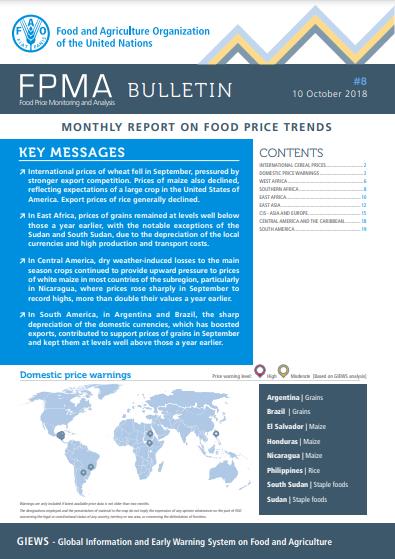
Food Price Monitoring and Analysis (FPMA) Bulletin #8, 10 October 2018
10/10/2018
International prices of wheat fell in September, pressured by stronger export competition. Prices of maize also declined, reflecting expectations of a large crop in the United States of America. Export prices of rice generally declined. In East Africa, prices of grains remained at levels well below those a year earlier, with the notable exceptions of the Sudan and South Sudan, due to the depreciation of the local currencies and high production and transport costs. In Central America, dry weather-induced losses to the main season crops continued to provide upward pressure to prices of white maize in most countries of the subregion, particularly in Nicaragua, where prices rose sharply in September to record highs, more than double their values a year earlier. In South America, in Argentina and Brazil, the sharp depreciation of the domestic currencies, which has boosted exports, contributed to support prices of grains in September and kept them at levels well above those a year earlier.
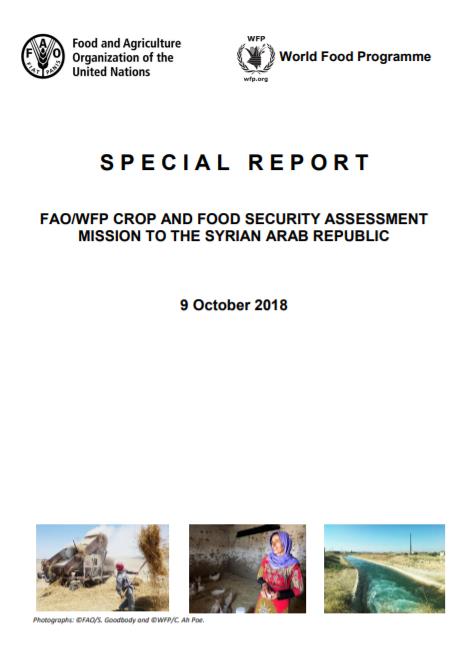
Special Report - FAO/WFP Crop and Food Security Assessment Mission to the Syrian Arab Republic - 9 October 2018
09/10/2018
A joint FAO/WFP Crop and Food Security Mission (CFSAM) visited the Syrian Arab Republic between 25 June and 19 July 2018 to estimate crop production and to assess the overall food security situation. On arrival in the country, the international members of the CFSAM team spent five days in Damascus prior to going to the field. During that time, they held meetings with the Ministry of Agriculture and Agrarian Reform (MAAR) and a number of other relevant ministries and state bodies of the Government of the Syrian Arab Republic. Following two weeks of data collection in the field in six governorates, the CFSAM team returned to Damascus to be briefed by MAAR officials who had collected further data independently in all governorates, and, most importantly, in governorates that the international team had been unable to visit. This was followed by a second round of meetings with the main technical directorates of MAAR. Prior to departure from the country, the Mission briefed the Minister of Agriculture and Agrarian Reform on its main findings.
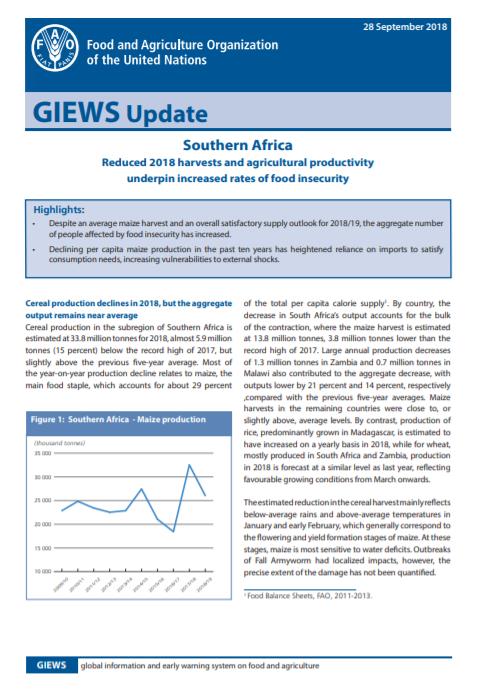
GIEWS Update - Southern Africa, 28 September 2018
28/09/2018
Despite an average maize harvest and an overall satisfactory supply outlook for 2018/19, the aggregate number of people affected by food insecurity has increased. Declining per capita maize production in the past ten years has heightened reliance on imports to satisfy consumption needs, increasing vulnerabilities to external shocks.
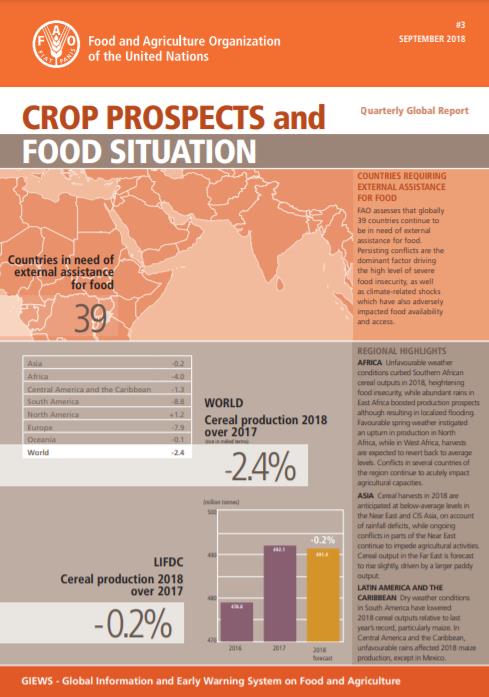
Crop Prospects and Food Situation - Quarterly Global Report, No. 3, September 2018
19/09/2018
FAO assesses that globally 39 countries continue to be in need of external assistance for food. Persisting conflicts are the dominant factor driving the high level of severe food insecurity, as well as weather shocks which have also adversely impacted food availability and access.
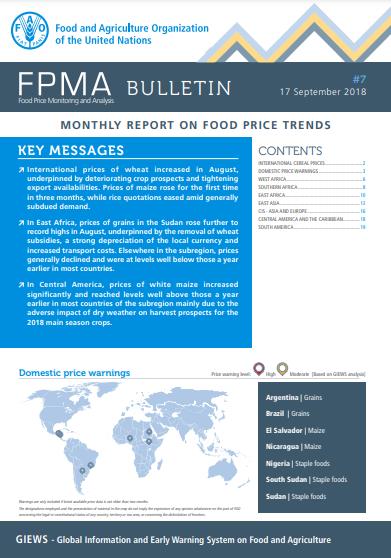
Food Price Monitoring and Analysis (FPMA) Bulletin #7, 17 September 2018
17/09/2018
International prices of wheat increased in August, underpinned by deteriorating crop prospects and tightening export availabilities. Prices of maize rose for the first time in three months, while rice quotations eased amid generally subdued demand. In East Africa, prices of grains in the Sudan rose further to record highs in August, underpinned by the removal of wheat subsidies, a strong depreciation of the local currency and increased transport costs. Elsewhere in the subregion, prices generally declined and were at levels well below those a year earlier in most countries. In Central America, prices of white maize increased significantly and reached levels well above those a year earlier in most countries of the subregion mainly due to the adverse impact of dry weather on harvest prospects for the 2018 main season crops.
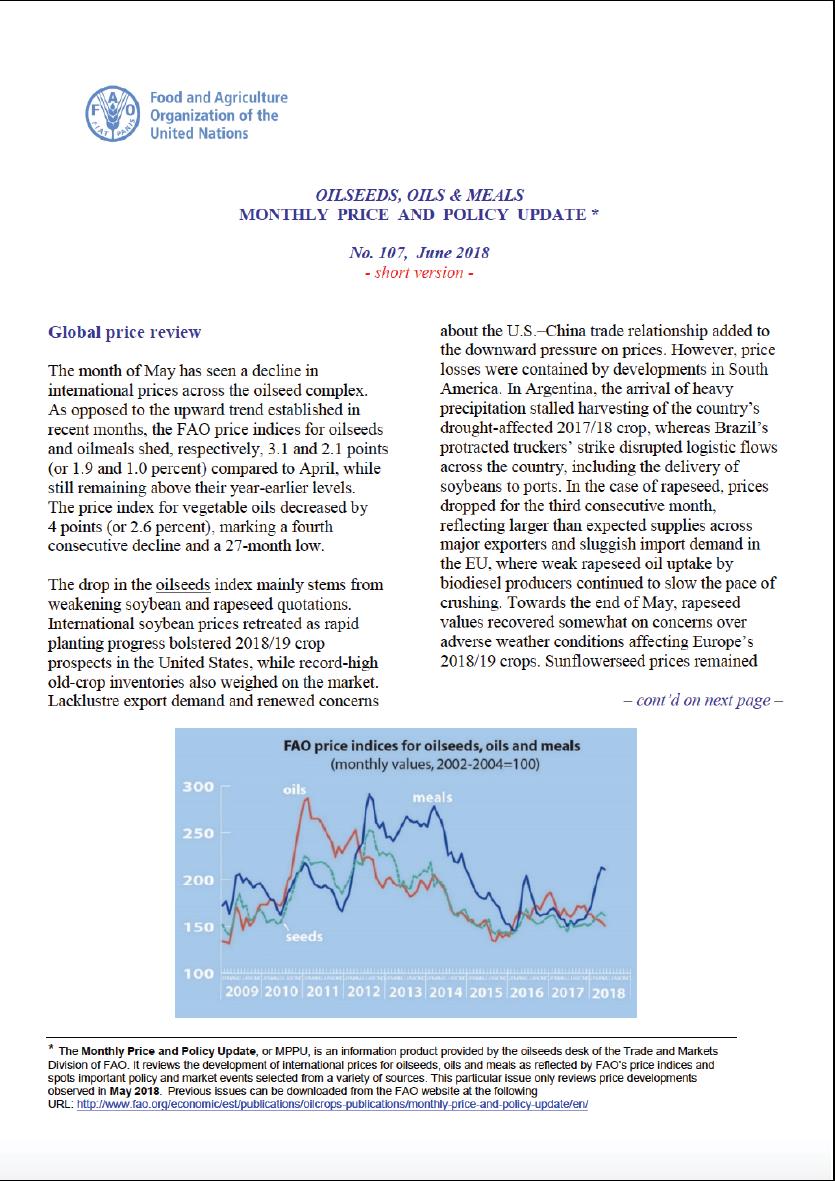
Oilseeds, Oils and Meals. Monthly Price and Policy Update No.107, June 2018
13/09/2018
The month of May has seen a decline in international prices across the oilseed complex. As opposed to the upward trend established in recent months, the FAO price indices for oilseeds and oilmeals shed, respectively, 3.1 and 2.1 points (or 1.9 and 1.0 percent) compared to April, while still remaining above their year-earlier levels. The price index for vegetable oils decreased by 4 points (or 2.6 percent), marking a fourth consecutive decline and a 27-month low.
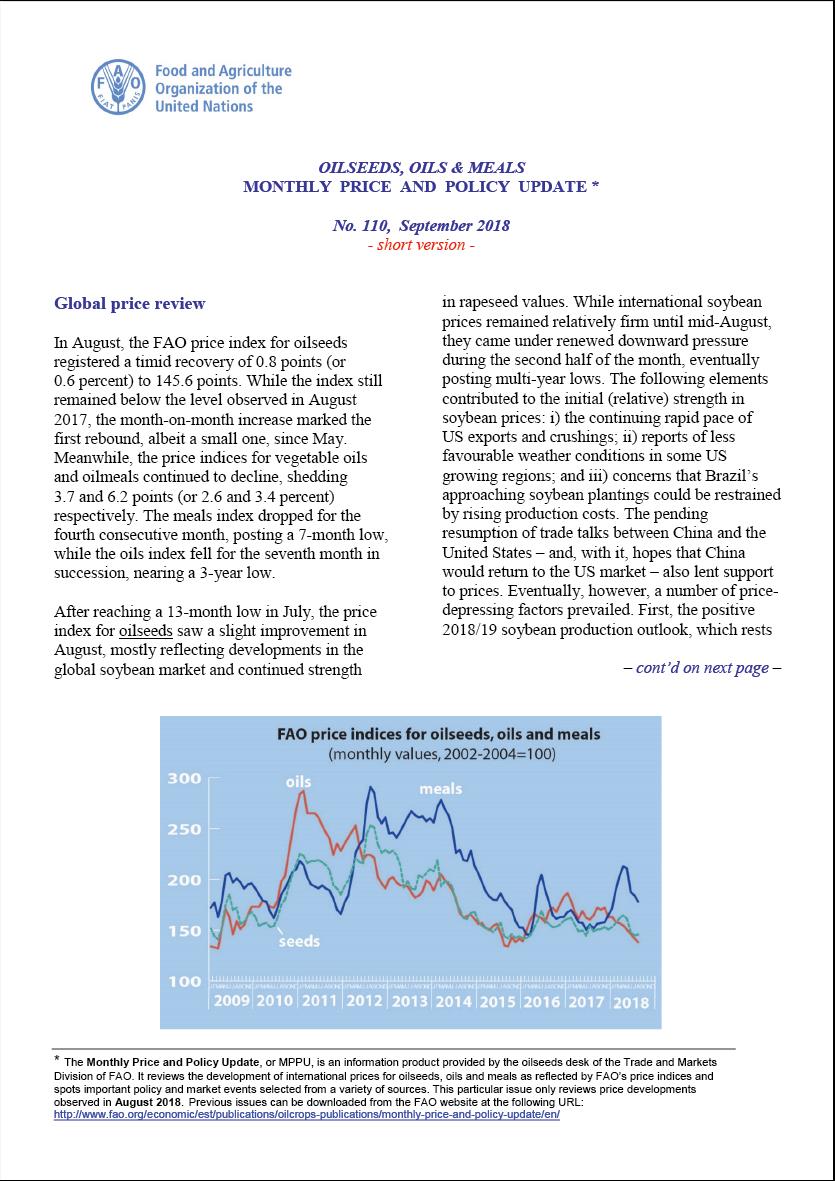
Oilseeds, Oils and Meals. Monthly Price and Policy Update No.110, September 2018
13/09/2018
In August, the FAO price index for oilseeds registered a timid recovery of 0.8 points (or 0.6 percent) to 145.6 points. While the index still remained below the level observed in August 2017, the month-on-month increase marked the first rebound, albeit a small one, since May. Meanwhile, the price indices for vegetable oils and oilmeals continued to decline, shedding 3.7 and 6.2 points (or 2.6 and 3.4 percent) respectively. The meals index dropped for the fourth consecutive month, posting a 7-month low, while the oils index fell for the seventh month in succession, nearing a 3-year low.
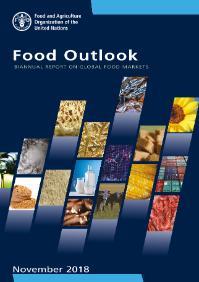
Food Outlook - September 2018
13/09/2018
Food Outlook analyses trends and developments in the markets for cereals, the oilseeds complex, sugar, meat, dairy and fish products. The November edition also offers a detailed analysis of the cassava markets and the protracted decline in international coffee prices. An additional feature article analyses the recent conditions in the global markets for bananas and major tropical fruits, where world trade is foreseen to surge by 18 percent from last year. The outlook for global supplies of agricultural commodities in the 2018/19 marketing season remains broadly in line with earlier expectations. While the weather had some impact on crop prospects, the overall production at global level did not change significantly from the forecasts published in the July issue of Food Outlook. Beyond weather-induced revisions, the latest FAO revisions take into consideration the mounting uncertainties regarding trade policies, as well as the changes in exchange rates and rising energy prices.
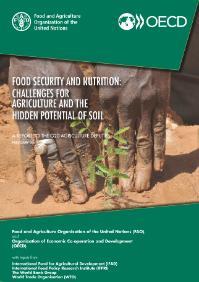
Food security and nutrition: Challenges for agriculture and the hidden potential of soil
13/09/2018
Report, prepared by FAO and the OECD with inputs from IFPRI, IFAD, the World Bank and WTO, submitted to the G20 Presidency of the Republic of Argentina in response to the Presidency’s request for information on future trends and challenges faced by global agriculture, with a special focus on the role of soils in promoting food security and the measures that could be undertaken to facilitate sustainable soil management.
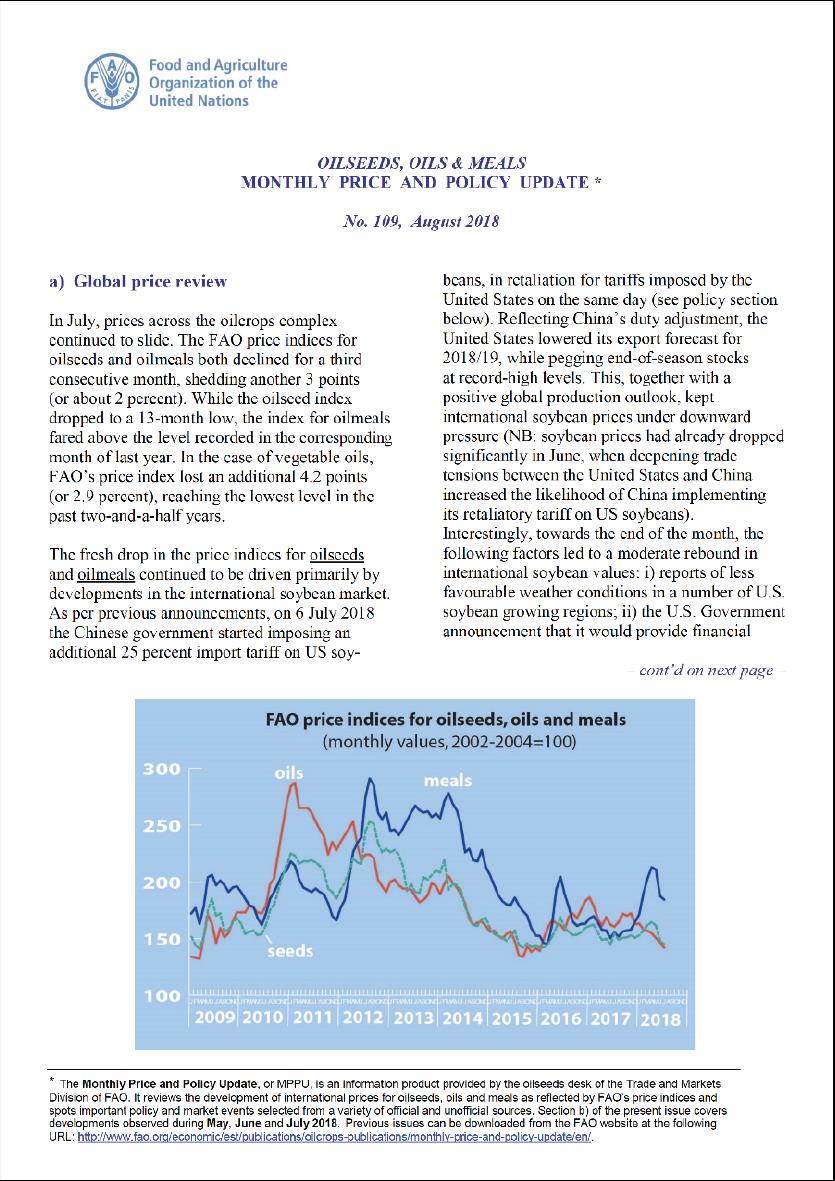
Oilseeds, Oils and Meals. Monthly Price and Policy Update No.109, August 2018
13/09/2018
In July, prices across the oilcrops complex continued to slide. The FAO price indices for oilseeds and oilmeals both declined for a third consecutive month, shedding another 3 points (or about 2 percent). While the oilseed index dropped to a 13-month low, the index for oilmeals fared above the level recorded in the corresponding month of last year. In the case of vegetable oils, FAO’s price index lost an additional 4.2 points (or 2.9 percent), reaching the lowest level in the past two-and-a-half years.
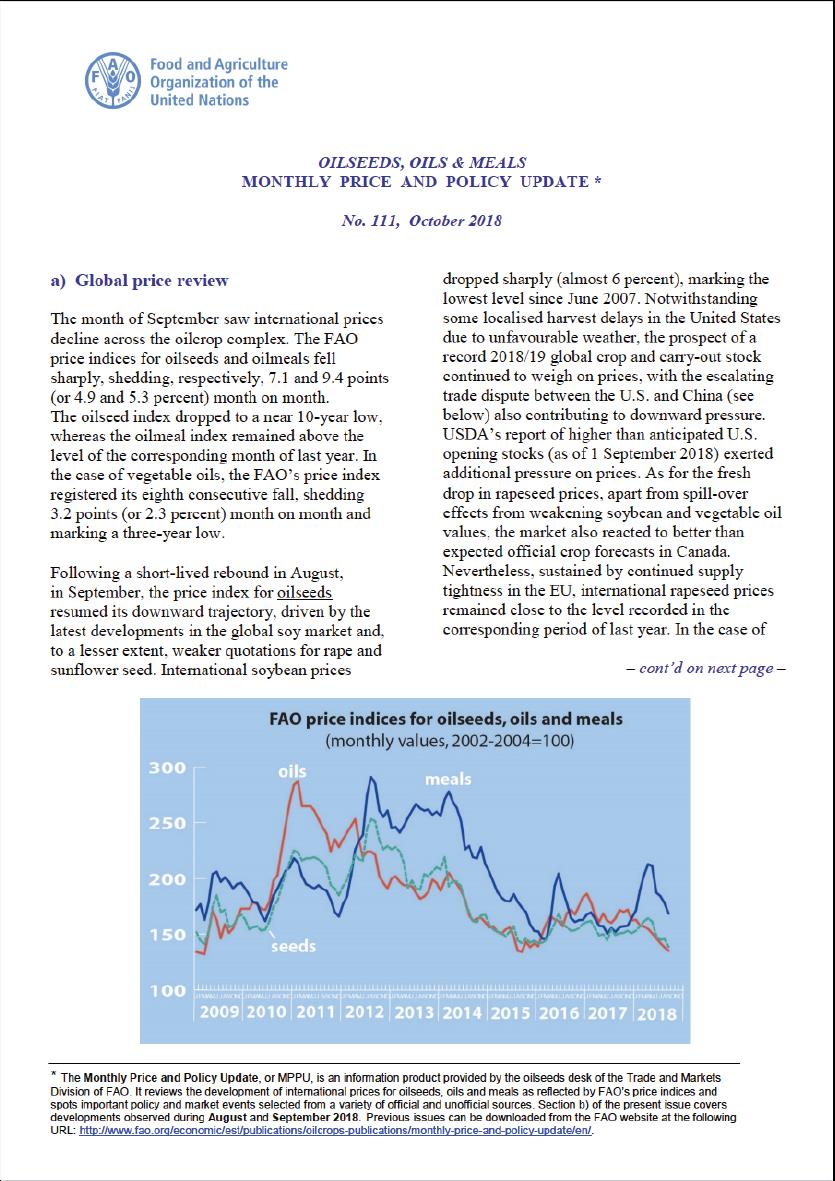
Oilseeds, Oils and Meals. Monthly Price and Policy Update No.111, October 2018
13/09/2018
The month of September saw international prices decline across the oilcrop complex. The FAO price indices for oilseeds and oilmeals fell sharply, shedding, respectively, 7.1 and 9.4 points (or 4.9 and 5.3 percent) month on month. The oilseed index dropped to a near 10-year low, whereas the oilmeal index remained above the level of the corresponding month of last year. In the case of vegetable oils, the FAO’s price index registered its eighth consecutive fall, shedding 3.2 points (or 2.3 percent) month on month and marking a three-year low.
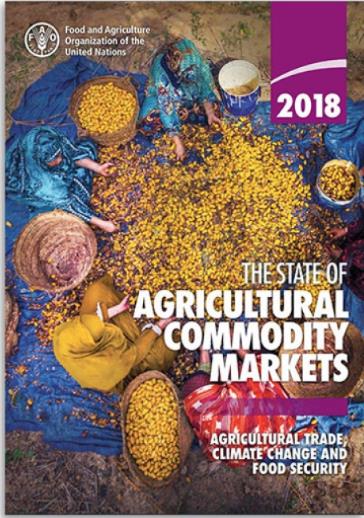
The State of Agricultural Commodity Markets (SOCO) 2018
13/09/2018
Global agricultural trade has increased significantly in value terms since 2000. Its pattern has also changed – emerging economies and developing countries play a bigger role in international markets, and South–South agricultural trade has expanded significantly. Climate change is expected to affect agriculture, food security and nutrition unevenly across countries and regions. Changes in comparative advantage in agriculture around the world will also affect international trade.
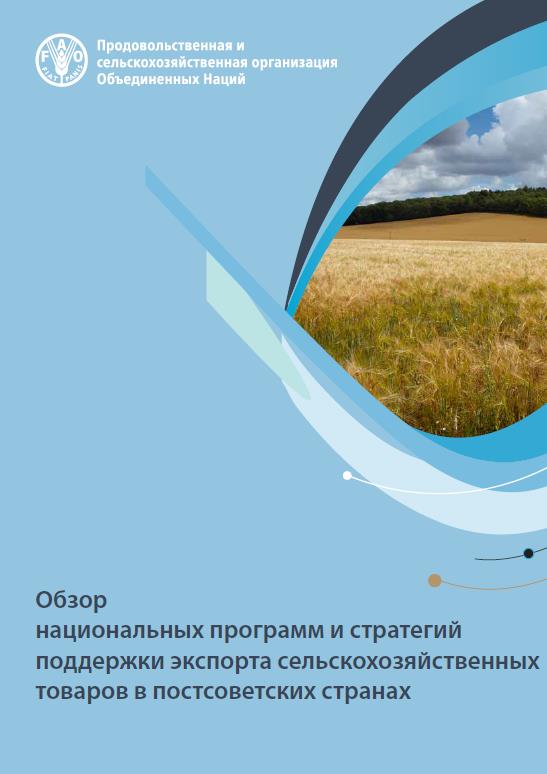
National programs and strategies in support of agri-food exports in post-Soviet countries
13/09/2018
This review focuses on the various aspects of post-Soviet countries' policies in support of agri-food products export. The report contains an analysis of agricultural exports of these countries in recent years. This includes the latest initiatives in the field of stimulating food supplies to the foreign market are considered, and the national legislation promoting exports is described. Moreover, the review consolidates information in relation to the export support systems within post-Soviet countries, including governmental institutions, state export support agencies and non-governmental institutions. The report also evaluates the key instruments and measures for agricultural exports promotion in countries of the region, in particular, to the financing of export promotion measures from the state budget.
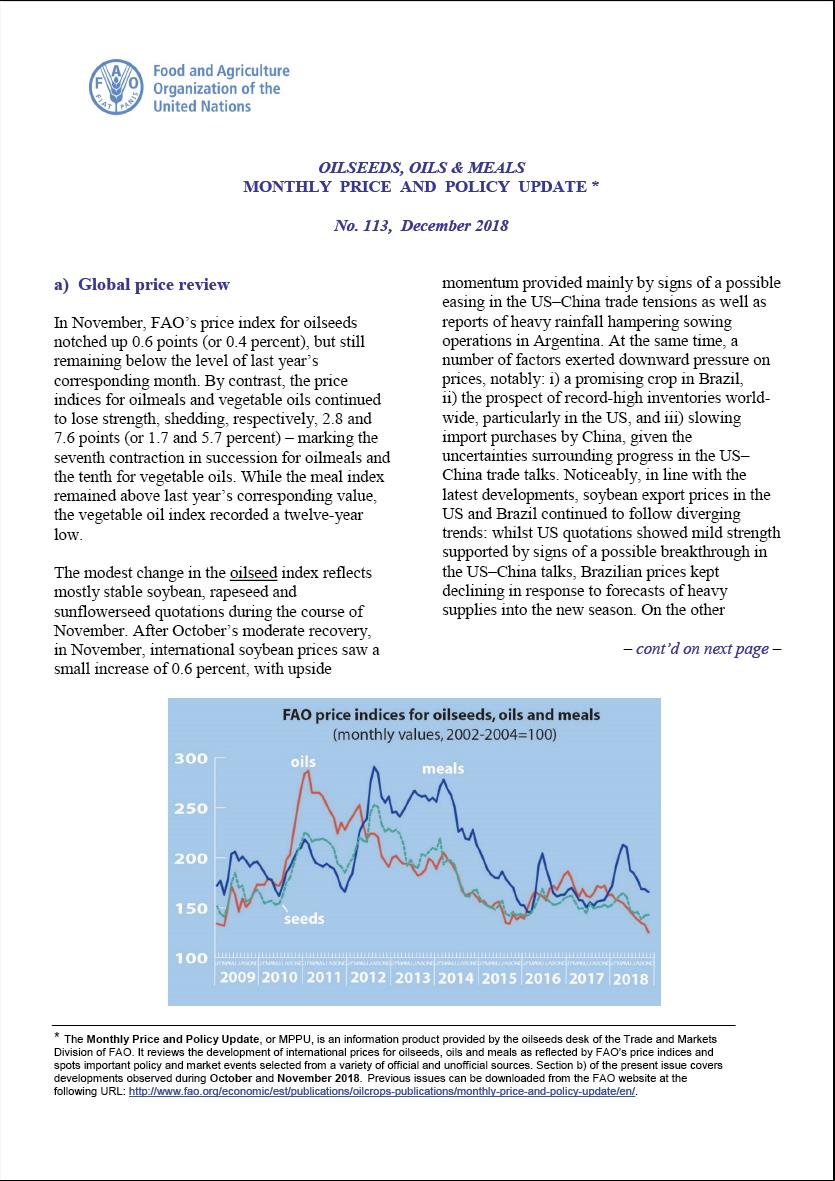
Oilseeds, Oils and Meals. Monthly Price and Policy Update No.113, December 2018
13/09/2018
In November, FAO’s price index for oilseeds notched up 0.6 points (or 0.4 percent), but still remaining below the level of last year’s corresponding month. By contrast, the price indices for oilmeals and vegetable oils continued to lose strength, shedding, respectively, 2.8 and 7.6 points (or 1.7 and 5.7 percent) – marking the seventh contraction in succession for oilmeals and the tenth for vegetable oils. While the meal index remained above last year’s corresponding value, the vegetable oil index recorded a twelve-year low.
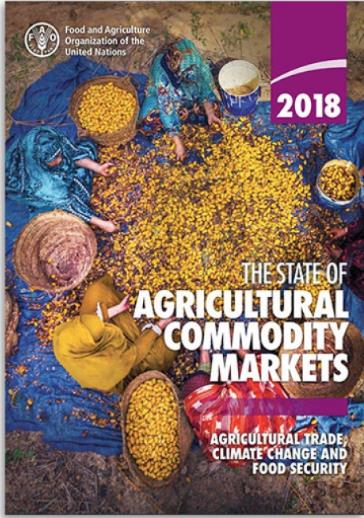
The State of Agricultural Commodity Markets 2018
13/09/2018
Global agricultural trade has increased significantly in value terms since 2000. Its pattern has also changed – emerging economies and developing countries play a bigger role in international markets, and South–South agricultural trade has expanded significantly. Climate change is expected to affect agriculture, food security and nutrition unevenly across countries and regions. Changes in comparative advantage in agriculture around the world will also affect international trade. This edition of The State of Agricultural Commodity Markets focuses on the complex and underexplored intersection between agricultural trade, climate change and food security. The report makes an important contribution to the policy debates on climate change adaptation and mitigation under the Paris Agreement and the multilateral agricultural trade rules. The report discusses policies – both domestic support and trade measures – that can promote food security, adaptation and mitigation, and improve the livelihoods of family farmers around the world. Given both the slow- and rapid-onset impacts of climate change, policies that can significantly promote climate change adaptation and mitigation would benefit from deeper discussions in international fora on how to strengthen the mutually supportive role of trade rules and climate interventions
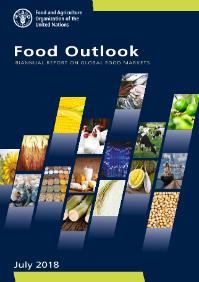
Food Outlook
13/09/2018
Food Outlook is published by the Trade and Markets Division of FAO under Global Information and Early Warning System (GIEWS). It is a biannual publication focusing on developments affecting global food and feed markets. Each report provides comprehensive assessments and short term forecasts for production, utilization, trade, stocks and prices on a commodity by commodity basis and includes feature articles on topical issues. Food Outlook maintains a close synergy with another major GIEWS publication, Crop Prospects and Food Situation, especially with regard to the coverage of cereals. Food Outlook is available in English. The summary section is also available in Arabic, Chinese, French, Russian and Spanish.
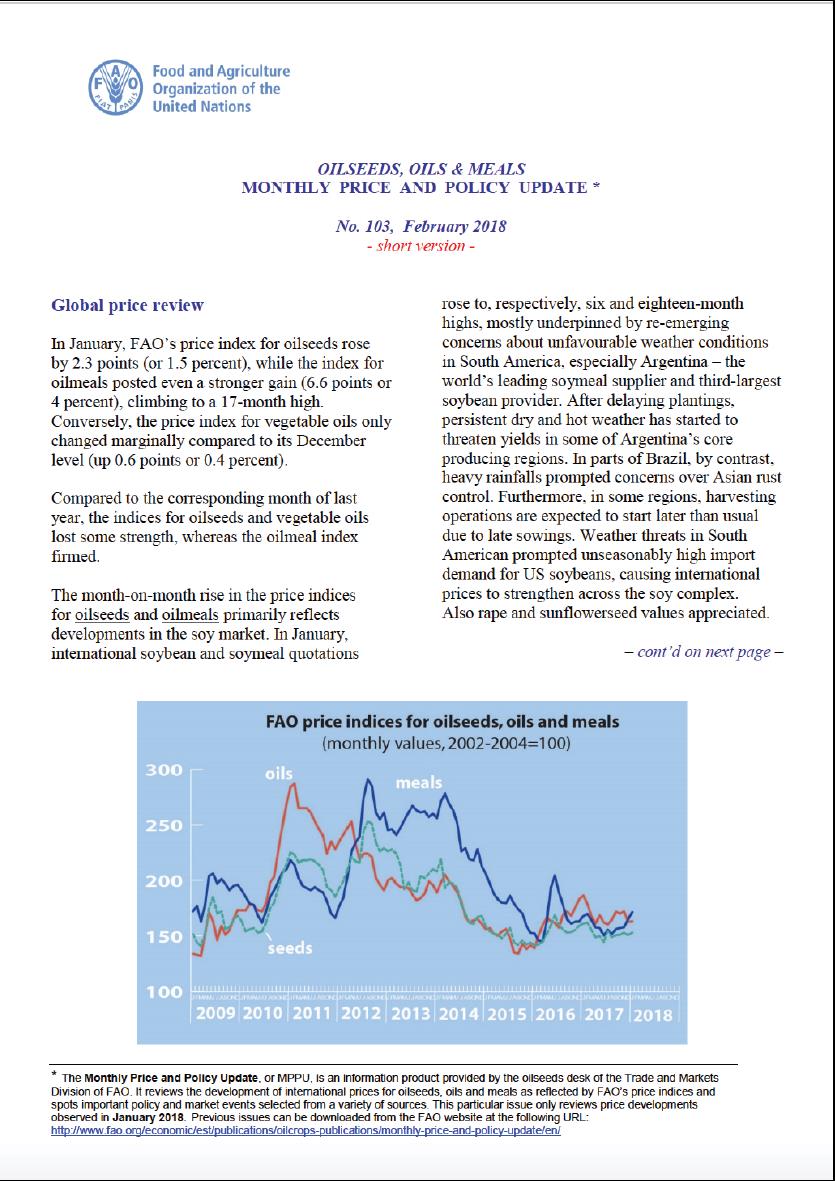
Oilseeds, Oils and Meals. Monthly Price and Policy Update No.103, February 2018
13/09/2018
In January, FAO’s price index for oilseeds rose by 2.3 points (or 1.5 percent), while the index for oilmeals posted even a stronger gain (6.6 points or 4 percent), climbing to a 17-month high. Conversely, the price index for vegetable oils only changed marginally compared to its December level (up 0.6 points or 0.4 percent).
